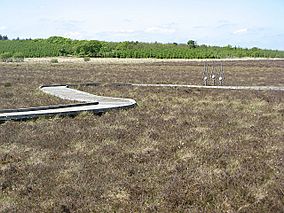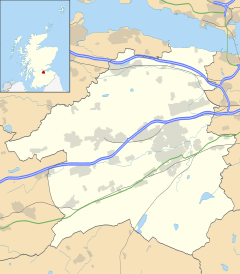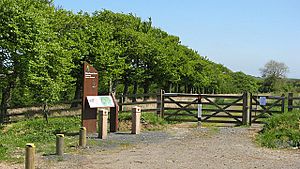Blawhorn Moss facts for kids
Quick facts for kids Blawhorn Moss National Nature Reserve |
|
|---|---|
|
IUCN Category IV (Habitat/Species Management Area)
|
|

Boardwalk in Blawhorn Moss National Nature Reserve
|
|
| Location | Blackridge, West Lothian, Scotland |
| Area | 108 hectares (270 acres) |
| Governing body | NatureScot |
| Blawhorn Moss National Nature Reserve | |
Blawhorn Moss is a special kind of wetland called a raised bog. It's found near the village of Blackridge in West Lothian, Scotland. This amazing place is the biggest and most untouched raised bog in the Lothians area.
Since 1980, Blawhorn Moss has been a National Nature Reserve. This means it's a protected area managed by NatureScot. NatureScot is a public group that looks after Scotland's natural places. Blawhorn Moss is also a Special Area of Conservation and a Site of Special Scientific Interest. These titles show how important it is for nature.
Contents
What Lives at Blawhorn Moss?
Blawhorn Moss is a fantastic home for many plants and animals. It's a great example of a healthy bog habitat.
Plants of the Bog
You can find many types of sphagnum mosses here. These mosses are very important for bogs. Other plants include heather, crowberry, and two kinds of cotton grass: hare's-tail cotton grass and common cotton grass.
Animals and Birds
Many different birds come to Blawhorn Moss to nest. Look out for red grouse, snipe, curlew, and redshank. In spring and summer, you might also see stonechats, skylarks, and meadow pipits. The reserve is also buzzing with butterflies, dragonflies, and damselflies.
Why Bogs Are Important
Blawhorn Moss is the largest and healthiest peatland in the Lothians. Peatlands are super important because they help fight climate change. They act like giant sponges, soaking up carbon from the air. This makes them a natural "carbon sink". In Scotland, peat soils hold much more carbon than all other plants combined! Sadly, many bogs in Central Scotland have been damaged. This happened because people drained them for farming, cutting peat, or planting trees.
History of the Reserve
Blawhorn Moss has an interesting past. It shows how much effort goes into protecting nature.
Changes Over Time
In the 1940s, people drained the moss. They wanted to use the land for farming. Later, the National Coal Board owned the area. Even though nearby areas were used for opencast coal mining, Blawhorn Moss stayed safe.
Protecting the Moss
In 1979, the Nature Conservancy Council bought part of the moss. This group was the one before NatureScot. Since then, people have worked hard to make the moss healthy again. They blocked the old drains that had dried out the land. This helps the water stay in the bog.
Fires caused problems between the 1980s and 2001. A big fire in 2001 damaged some of the water dams. Stronger dams were built to fix this. More land was bought in 2001, and the reserve grew in 2008.
Visiting Blawhorn Moss
National Nature Reserves like Blawhorn Moss help people learn about Scotland's amazing nature.
Paths and Access
There are paths around the reserve. These paths connect to other local walking routes near Blackridge. You can also drive to the reserve and park your car in the car park.
Learning About the Moss
At the car park, you'll find signs that tell you about the reserve. There's also a viewpoint where you can look out over the moss. NatureScot has even made a leaflet to help visitors explore and learn more.



